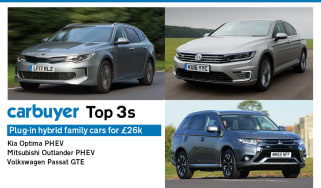Mitsubishi Outlander PHEV SUV review (2014-2021)
“The Mitsubishi Outlander PHEV was an excellent plug-in hybrid option at launch but it now feels dated”
Pros
- Plenty of standard equipment
- Excellent fuel economy
- Affordable for a plug-in hybrid
Cons
- Batteries reduce boot space
- Starting to show its age
- Only average to drive
The Mitsubishi Outlander PHEV was a trailblazer in the UK when it first launched, offering buyers their first chance to try a plug-in hybrid: a car with a battery and electric motor that could be charged like an electric car, yet still had an engine for longer trips.
It still has the same layout today, albeit with some small changes, but it’s no longer the dominant force it was then. That’s largely because it was the only car of its type at that time and its ultra-low company-car tax liability meant it was very popular.
 Top 10 best economical 4x4s, SUVs and crossovers
Top 10 best economical 4x4s, SUVs and crossovers
Yet with the arrival of cars such as the Kia Niro plug-in hybrid, the MINI Countryman Cooper S E ALL4 and Volvo XC60 T8 Twin Engine, as well as the newer Ford Kuga PHEV and Peugeot 3008 Hybrid, the Outlander has fallen behind and now seems less appealing.
It’s also worth remembering that in 2020, Mitsubishi announced that it would stop selling cars in the UK, so the only cars available are already built - you can’t order a new one. As a used buy, it could be worth a look for some buyers.
Look out for models made after 2018, which did away with the previous version’s 2.0-litre petrol engine and got a newer 2.4-litre engine plus a new battery pack and electric motor. This improved range and efficiency, so it’s a better buy.
The battery capacity was increased, too, and its 13.8kWh is claimed to provide an all-electric range of up to 28 miles in normal driving. Driven normally, the Outlander can act as a hybrid, but to get close to its impressive 140mpg (WLTP) claimed fuel-economy figure, you’ll need to top up the battery pack from your home electricity supply, or at a public charging point, and adopt a very leisurely approach to driving.
More reviews
As with any plug-in hybrid, the technology suits some owner’s lifestyles better than others. If you mostly drive in the city, have a charger readily available and your usual daily round trip doesn't exceed that 28-mile range, you may hardly use a drop of petrol. If you spend most of your time driving big miles on the motorway, you won’t see much of an improvement over the petrol Mitsubishi Outlander. Owners can also benefit from perks such as the ‘Cleaner Vehicle Discount’ allowing free entry to the London Congestion Charge zone thanks to the Outlander PHEVs 46g/km CO2 emissions, and this could prove even handier in future, as more towns and cities plan to introduce similar measures.
Factors such as these have spurred on the Outlander PHEV’s success, with company-car drivers especially appreciative of its low Benefit-in-Kind (BiK) band. Private buyers have also been drawn by its relatively low forecourt price, especially when the only other plug-in hybrid large SUVs have so far been much more expensive models like the Audi Q7 e-tron and Volvo XC60 T8 Twin Engine. If you’re considering a used model you’ll find that it’s not quite as good value, since the more upmarket models tend to lose more of their value.
There are four trim levels to look out for. The entry-level Verve does come with (a rather basic-looking) digital radio, heated front seats, rear parking sensors and dual-zone climate control, but you’ve got to step up to Design to get a touchscreen media system with Apple CarPlay and Android Auto, plus a reversing camera and 18-inch alloy wheels.
Dynamic adds leather upholstery, blind-spot warning and a powered driver’s seat, while top-spec Exceed features quilted leather, LED headlights, sat nav, a heated steering wheel and a powered tailgate. Both of these trim levels can have a safety pack added on, with tech like lane-departure warning and auto high beam.
The interior is straightforward, but not especially interesting to look at. In fact, it looks quite dated in places, yet it's roomy and comfortable. It’s not as versatile as the standard car’s, though, because the need to accommodate the batteries means there’s no seven-seat option. At least the boot is only a little smaller.
Visibility is good and even with the petrol engine running, the PHEV is quiet and free of vibration – especially with the larger 2.4-litre engine fitted. It’s a little slow, though, because the batteries are so heavy. This extra weight means it leans excessively in corners and overwhelms the suspension, making the ride uncomfortable.
Fortunately, thanks to four-wheel drive and traction control, the Outlander PHEV is reassuring on poor or slippery road surfaces, which makes it an appealing all-year-round proposition. Families will also appreciate the fact that Euro NCAP awarded the Outlander PHEV the full five stars for crash protection.
See how this car scored on our sister site Driving Electric










